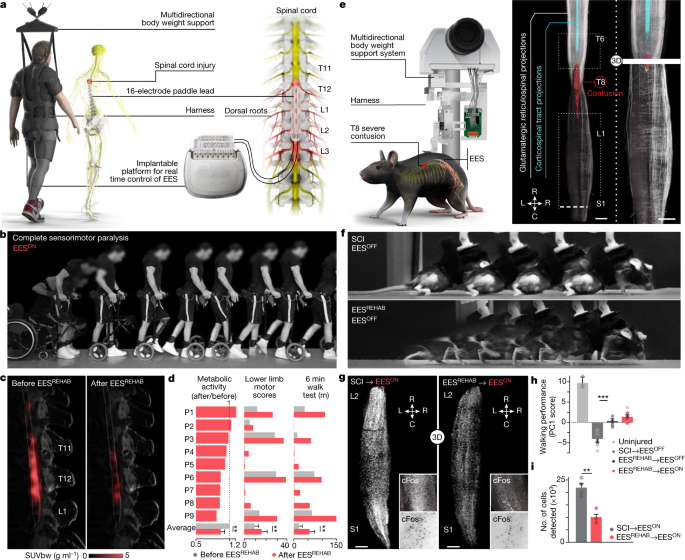2022-11-09 スイス連邦工科大学ローザンヌ校(EPFL)
複数年の研究プログラムでは、脊髄損傷で麻痺した患者が、足の動きを制御する部位に標的硬膜外電気刺激を受けることにより、一部の運動機能を取り戻すことに成功している。
新しい研究では、この治療法の有効性が9人の患者で実証されただけでなく、運動機能の改善は、神経リハビリテーションのプロセスが終了し電気刺激を止めた後も患者において持続することが明らかにされた。これは、歩行に使われる神経線維が再編成されたことを示唆している。
研究チームは、このメカニズムを解明するために、まずマウスを用いた研究を行った。その結果、Vsx2遺伝子を発現する神経細胞群に驚くべき性質があることがわかった。これらの神経細胞は、健康なマウスでは歩行に必要ないが、脊髄損傷後の運動機能の回復に不可欠であったのだ。
EPFLのStéphanie Lacour教授は、発光ダイオードを追加してインプラントを改良し、脊髄を刺激するだけでなく、光遺伝学的プロセスによってVsx2ニューロンだけを不活性化することも可能にしたのである。このシステムを脊髄損傷マウスに使用したところ、神経細胞が不活性化した結果、マウスは直ちに歩かなくなったが、健康なマウスには影響がなかった。このことは、脊髄刺激療法が効果を発揮し、神経の再編成をもたらすためには、Vsx2ニューロンが必要かつ十分であることを示唆している。
<関連情報>
- https://actu.epfl.ch/news/scientists-identify-neurons-that-restore-walking-a/
- https://www.nature.com/articles/s41586-022-05385-7
麻痺した歩行を回復させる神経細胞 The neurons that restore walking after paralysis
Claudia Kathe,Michael A. Skinnider,Thomas H. Hutson,Nicola Regazzi,Matthieu Gautier,Robin Demesmaeker,Salif Komi,Steven Ceto,Nicholas D. James,Newton Cho,Laetitia Baud,Katia Galan,Kaya J. E. Matson,Andreas Rowald,Kyungjin Kim,Ruijia Wang,Karen Minassian,John O. Prior,Leonie Asboth,Quentin Barraud,Stéphanie P. Lacour,Ariel J. Levine,Fabien Wagner,Jocelyne Bloch,Jordan W. Squair & Grégoire Courtine
Nature Published:09 November 2022
DOI:https://doi.org/10.1038/s41586-022-05385-7

Abstract
A spinal cord injury interrupts pathways from the brain and brainstem that project to the lumbar spinal cord, leading to paralysis. Here we show that spatiotemporal epidural electrical stimulation (EES) of the lumbar spinal cord1,2,3 applied during neurorehabilitation4,5 (EESREHAB) restored walking in nine individuals with chronic spinal cord injury. This recovery involved a reduction in neuronal activity in the lumbar spinal cord of humans during walking. We hypothesized that this unexpected reduction reflects activity-dependent selection of specific neuronal subpopulations that become essential for a patient to walk after spinal cord injury. To identify these putative neurons, we modelled the technological and therapeutic features underlying EESREHAB in mice. We applied single-nucleus RNA sequencing6,7,8,9 and spatial transcriptomics10,11 to the spinal cords of these mice to chart a spatially resolved molecular atlas of recovery from paralysis. We then employed cell type12,13 and spatial prioritization to identify the neurons involved in the recovery of walking. A single population of excitatory interneurons nested within intermediate laminae emerged. Although these neurons are not required for walking before spinal cord injury, we demonstrate that they are essential for the recovery of walking with EES following spinal cord injury. Augmenting the activity of these neurons phenocopied the recovery of walking enabled by EESREHAB, whereas ablating them prevented the recovery of walking that occurs spontaneously after moderate spinal cord injury. We thus identified a recovery-organizing neuronal subpopulation that is necessary and sufficient to regain walking after paralysis. Moreover, our methodology establishes a framework for using molecular cartography to identify the neurons that produce complex behaviours.


